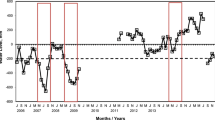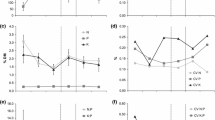Abstract
The relationship was studied between shoot biomass, nutrient concentration in the soil and number of species per unit area. The study was carried out in two different parts of the Netherlands, the Gelderse Vallei (east of Amersfoort) and the Westbroekse Zodden (northwest of Utrecht). Four series of vegetation and soil samples were taken: one series in grassland and wetland communities, one series in grassland communities, one series in fen communities and one series in only one wetland community.
The two series in grassland communities show a negative correlation between shoot biomass and species number and a positive correlation between shoot biomass and nutrient concentration in the soil. The opposite was found in the series in the fen communities: there was a positive correlation between species number and shoot biomass and a negative correlation between shoot biomass and nutrient concentrations. The series of samples that had been taken in only one wetland community showed an optimum curve for the relation between shoot biomass and number of species. It is concluded that in the plant communities studied the species richness per unit area increases with increasing productivity at low production levels (< 400–500 g/m2) and decreases with increasing productivity at higher production levels (> 400–500 g/m2).
Similar content being viewed by others
References
Al-Mufti, M. M., Sydes, C. L., Furness, S. B., Grime, J. P. & Band, S. R., 1977. A quantitative analysis of shoot phenology and dominance in herbaceous vegetation. J. Ecol. 65: 759–791.
Armstrong, W., 1975. Waterlogged soils. In: Etherington, J. R. (ed.), Environment and Plant Ecology, pp. 181–218. Wiley, London.
Berendse, F., 1981. Competition and equilibrium in grassland communities. Thesis, Utrecht, The Netherlands, 151 pp.
Bergh, J. P.van den, 1979. Changes in the composition of mixed populations of grassland species. In: Werger, M. J. A. (ed.), The Study of Vegetation, pp. 59–80. Junk, The Hague.
Bergh, J. P.van den & Braakhekke, W., 1978. Coexistence of plant species by niche differentiation. In: Freysen, A. H. J. & Woldendorp, J. W. (eds.), Structure and Functioning of Plant Populations, pp. 155–187. North Holland Publ. Comp., Amsterdam.
Black, C. A., 1968. Soil-Plant Relationships. Wiley, New York.
Braakhekke, W., 1980. On coexistence: a causal approach to diversity and stability in grassland vegetation. Versl. Landbouwk. Onderzoek 902: 164 pp.
Brouwer, R., 1978. Soil physical conditions and plant growth. In: Freysen, A. H. J. & Woldendorp, J. W. (eds.), Structure and Functioning of Plant Populations, pp. 189–213. North Holland Publ. Comp., Amsterdam.
Ernst, W., 1978. Chemical soil factors determining plant growth. In: Freysen, A. H. J. & Woldendorp, J. W. (eds.), Structure and Functioning of Plant Populations, pp. 155–187. North Holland Publ. Comp., Amsterdam.
Etherington, J. R., 1975. Environment and Plant Ecology. Wiley, New York.
Golley, F. B. & Gentry, J. B., 1966. A comparison of variety and standing crop of vegetation on a one year and a twelve year old abandoned old field. Oikos 15: 185–199.
Grime, J. P., 1973a. Control of species density in herbaceous vegetation. J. Envir. Manage. 1: 151–167.
Grime, J. P., 1973b. Competitive exclusion in herbaceous vegetation. Nature 242: 344–347.
Grime, J. P., 1973c. Competition and diversity in a herbaceous vegetation (a reply). Nature 244: 311.
Grime, J. P., 1974. Vegetation classification with reference to strategies. Nature 250: 26–30.
Grime, J. P., 1978. Interpretation of small-scale patterns in the distribution of plant species in space and time. In: Freysen, A. H. J. & Woldendorp, J. W. (eds.), Structure and Functioning of Plant Populations, pp. 101–124. North Holland Publ. Comp., Amsterdam.
Grime, J. P. 1979. Plant Strategies and Vegetation Processes. Wiley, London, 222 pp.
Grubb, P. J., 1977. The maintenance of species richness in plant communities: The importance of the regeneration niche. Biol. Rev. 52: 107–145.
Heukels, H. & Ooststroom, S. J.van, 1977. Flora van Nederland. Wolters Noordhoff, Groningen.
Leeuwen, Chr. G.van, 1965. Het verband tussen natuurlijke en anthropogene landschapsvormen bezien vanuit hun betrekkingen in grensmilieus. Gorteria 2: 93–105.
Leauwen, Chr. G.van, 1966. Het botanisch beheer van natuurreservaten op structuur oecologische grondslag. Gorteria 3: 16–27.
Léon, R., 1968. Balance d'azote et d'eau les prairies humides. Veröff. Geobot. Inst. Rübel 41: 2–67.
Newman, E. J., 1973. Competition and diversity in herbaceous vegetation. Nature 244: 103.
Thurston, J. M., 1969. The effect of liming and fertilizers on the botanical composition of permanent grassland and the yield of hay. In: Rorison, I. H. (ed.), Ecological Aspeets of the Mineral Nutrition of Plants, pp. 3–10. Blackwell, Oxford.
Wheeler, B. D. & Giller, K. E., 1982. Species rienness of herbaceous fen vegetation in broadland, Norfolk in relation to the quantity of above ground plant material. J. Ecol. 70: 179–200.
Willems, J. H., 1980. Observations on North West European limestone grassland communities: an experimental approach to the study of species diversity and above ground biomass in chalk grassland. Proc. K.N.A.W. 83: 279–306.
Williams, E. D., 1978. Botanical composition of the Park Grass Plots at Rothamsted 1856–1976. Rothamsted Exp. Station. Harpenden, U.K.
Willis, A. J., 1963. Braunton Burrows: the effects on the vegetation of the addition of mineral nutrients to dune soils. J. Ecol. 51: 353–374.
Author information
Authors and Affiliations
Additional information
Nomenclature follows Heukels-Van Ooststroom (1977)
We are indebted to J. T. A. Verhoeven for critically reading the manuscript, to Mrs S. M. McNab for correcting the English text. The field data were collected in cooperation with Mrs A. Kooman. A. M. H. van Dongen and H. N. de Kruiif.
Rights and permissions
About this article
Cite this article
Vermeer, J.G., Berendse, F. The relationship between nutrient availability, shoot biomass and species richness in grassland and wetland communities. Vegetatio 53, 121–126 (1983). https://doi.org/10.1007/BF00043032
Accepted:
Issue Date:
DOI: https://doi.org/10.1007/BF00043032




